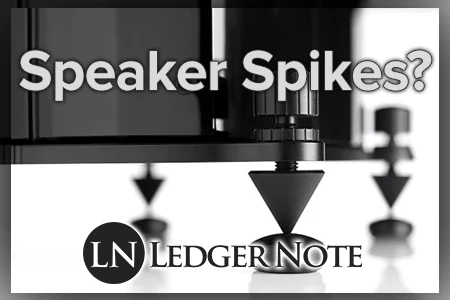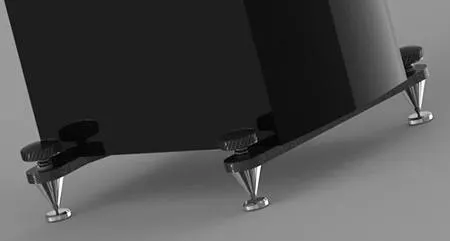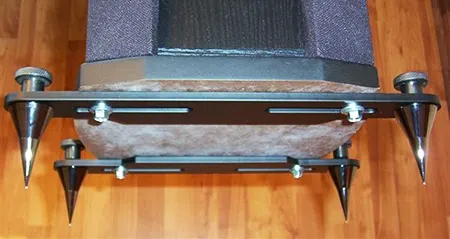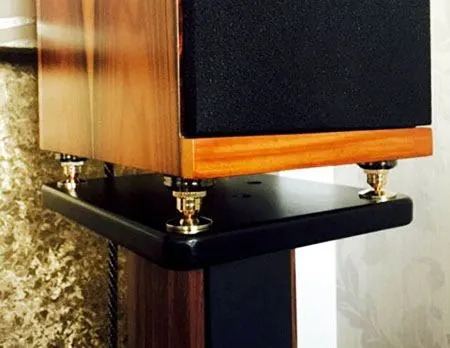We received a question recently that nearly drove me bonkers as I started to think more about it. I had formulated and sent my own answer back before reading some opinions on a few audiophile forums.
Let’s just say I’m not surprised to have read professionals in that crew stating the exact opposite conclusions from the same set of facts. Audiophiles don’t exactly operate in the same reality as the rest of us.

It was getting me confused too until I realized where and why they were going wrong. I’m glad to have taken that frustrating journey because it has helped me better the answer to this question, which is now deeper and longer than the original email exchange:
What Do Speaker Spikes Actually Do? Should I Be Using Them?
Question:
I’m always thinking about the way my studio looks as much as how good it sounds. I have some monitor isolation pads that look okay but they’re still foam. In my adventures online I saw people swearing by speaker spikes, and honestly they look amazing.
But nobody could articulate exactly what they do or how they do it. And that makes me think it involves magical thinking. Are these legit or just another audiophile fantasy?
Thanks,
Sean
Answer:
Sean, that’s a great question, and I agree, nobody in the audiophile world seems to be able to agree on what these spikes do or how they do it. Then, of course, you have the guys using ones that costed $10,000 dollars, made out of brass and a pure gold core. You also have the guys who sold their expensive ones because using a phone book or a rotten log from the backyard sounded better.
Summary of the Online Conversation
Let me summarize the online conversation first for the sake of other readers. Speaker spikes are little cones that are used to separate your studio monitors or entertainment system speakers from the object they’re resting on.
The entire reason for doing this is to decouple the two structures so that vibrations can’t pass between the two and affect the quality of the sound emanating from the speakers. And that makes sense, because decoupling is isolating and that’s obviously the purpose of the spikes based on their design.

These spikes are shaped like cones that have a wide base and then reduce down to either a point or a ball bearing, and the purpose is to reduce the surface area of the points of contact between the spikes and the speaker.
Typically you’d use four of them to create a sturdy base, but some people swear using only three sounds better even though they risk their speakers toppling over. I hear if you make them out of compressed magical pixie dust it sounds even better!
Now, at the same time you have audiophiles saying that the purpose of speaker spikes is to couple the speakers to the stands or desk surface. This is the exact opposite conclusion, and they support their arguments using analogies to football cleats that help a player get a better grip on the playing field.
I’m sure you can see why that’s a poor analogy already. If the goal was to couple the monitors to the stands, then what you’d want is to increase the mass of both while increasing the contact surface area, and then put rubber bands around the two and stack some concrete on top.
I’m not joking either. There are some extremely effective and legitimate methods of coupling speakers to a structure to avoid vibrations. But it’s much easier and cheaper to decouple them, and that’s why speaker spikes exist and take on the shape they do. Their goal is the same as foam monitor isolation pads, to decouple so vibrations can’t be passed around.
And that leads to the two points of confusion for audiophiles when it comes to these spikes.
The Confusion Around Speaker Spikes
Okay, so the reason people swear that these spikes do two opposite things is two-fold:
- They think speaker spikes are the same as speaker stand spikes.
- They don’t realize speakers are tuned to their cabinets and are meant to vibrate.
The second point is why you have audiophiles swearing that spikes make their speakers sound better, worse, do nothing, make it not better or worse but just different, etc. Most woofers are designed with heavy cabinets in mind that don’t allow recoil from the woofers to vibrate the overall speaker, and the micro-vibrations that are left are taken into account in the design and shape of the cabinet.
That’s why decoupling creates a tighter bass response and a better stereo image, because speakers are designed to accommodate their own vibrations. Coupling is a thing of the past.

But coupling is what speaker stand spikes are for, which are meant to go under your speaker stands (as opposed to spikes that go under your speakers to decouple). How does that makes sense? This is the main reason why people are confused.
Speaker stand spikes are designed for one single use in mind – to be used under speaker stands that are standing on a carpeted floor.
These carpet spikes achieve two goals. They dig through the carpet and not only make contact with the wooden floor beneath them but they also dig into the floor, which is why they’re longer and sharper. This keeps the recoil from the speakers from rocking the stand back and forth.
This wobbling can create all kinds of problems in your stereo imaging due to phasing and doppler effects, etc. But by digging into the floor, they also couple the stand to the overall structure of your home (like the cleats example above).
So what happens is your stands weren’t coupled to the floor before because there was a layer of carpet and carpet padding under them, so they were free to pass sympathetic vibrations back and forth to your speakers. But by literally spiking them to the floor, they pass these rogue vibrations on to the floor and beyond. It’s like electrical grounding, in a way.
But that’s not why we use spikes on speakers! We use them for the opposite effect. Funnily enough, people will use spikes on a concrete floor or will place coins or specially made washers under their speaker stand spikes so they don’t pierce their wood floors, which defeats the purpose of coupling altogether, but still helps to decouple.
The True Purpose of Speaker Spikes
That was a long, winding pre-explanation to clear up the confusion in the audiophile communities. “Spikes for stands look just like the ones for speakers, so therefore they must do the same thing.” WRONG!
Speaker spikes attempt to do the same thing as foam isolation pads but in a different way. Foam pads go between your speakers and your desk, stands, or floor to decouple the two and then collect and dissipate any vibrations.
Just like acoustic treatment using rigid fiberglass, the foam webbing will oscillate and convert the vibrations into heat so they never make it to the other side. Spikes do the same thing, but instead of oscillating, they try to block the vibrations from ever being able to pass through them by reducing the surface area at the point of contact to an infinitesimal amount.
The tip of a sphere or cone is so tiny that no vibration with a long waveform and high amplitude can pass through it. Look at the image below and try to envision that concept:

The goal of spikes under your speakers is to decouple them from the next surface. The goal of spikes under your stands is to couple them to the floor by anchoring into it.
When your stands or desk is massive enough and coupled to another massive structure, while your speakers are “floating above” them through decoupling, no vibrations can make it up from the floor and through your stands to your speakers. They’re simply too massive to vibrate from something as low energy as music or movies at even a high volume. It doesn’t require that much mass either.
Professional studio engineers will pour playground sand into their stands or soffit mount the speakers right into the walls. I’ve even heard of people pouring in liquid concrete and letting it solidify.
The only thing you’ll want to worry about after you achieving decoupling of your speakers from your stands which are coupled to the floor is to identify any resonating membranes left in the room and applying acoustic treatment to the walls and corners.
And that’s the final reason why every audiophile hears a different result even when using the same equipment, then they argue forever about it. It’s because, while they’re happy to spend ten grand on a cable, they never consider the effect of their acoustic environment on their listening experience. The shape and sizes of their rooms differ, and all they need is some acoustic treatment to solve it.
To answer your final question, yes, speaker spikes are legit as long as you know why you’re using them and where to apply them, and use them in conjunction with enough other attempts to clean up your acoustic hygiene to notice a real, and not imagined, difference.
That’s pretty confusing still. Let me know if I can ramble on any more in search of clarity,
Jared